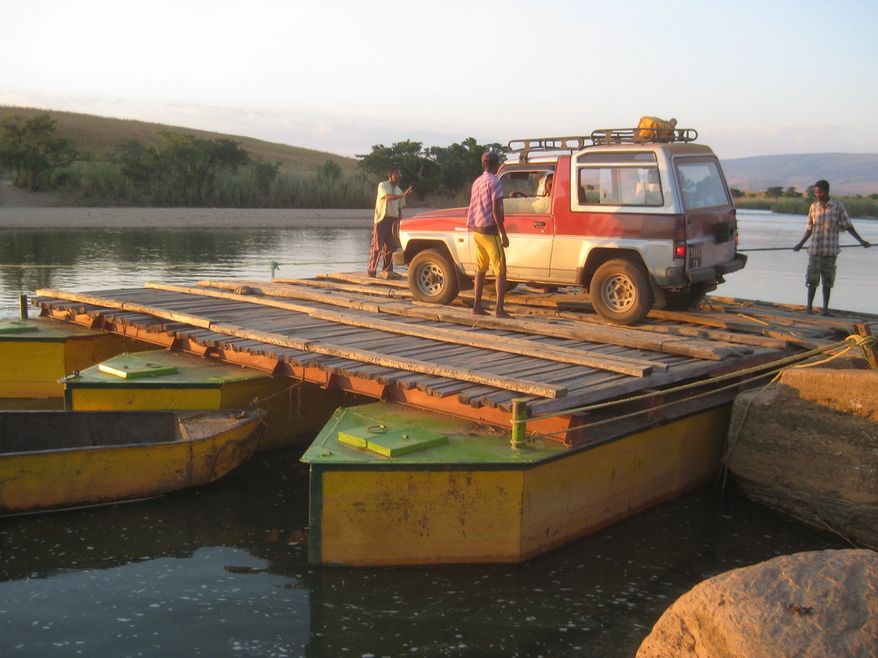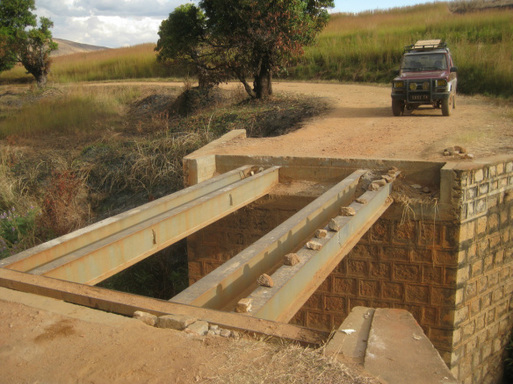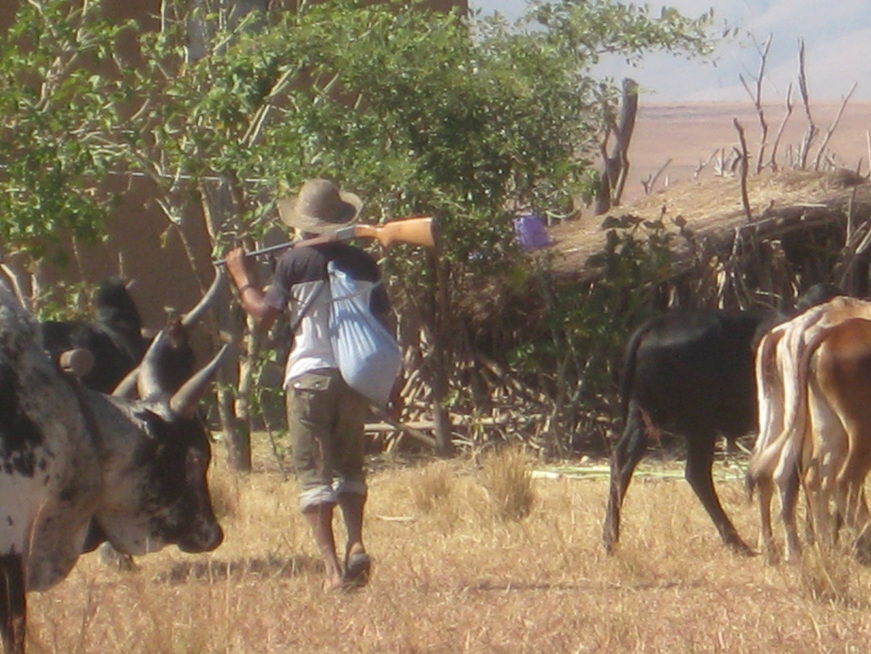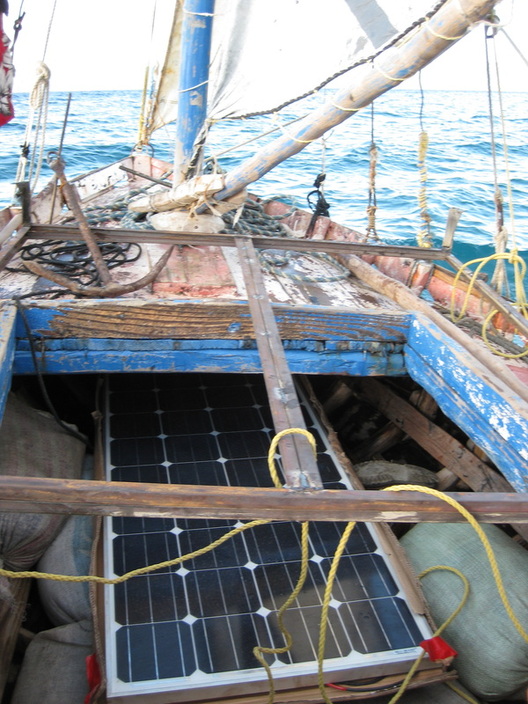|
I returned to Madagascar this year with two projects in mind - a solar hot water system and the repair of PV systems in remote clinics. My time was limited to six weeks, but in the end, that proved to be sufficient. I had already decided to wind down the operation in Madagascar and this trip was, in a sense, a farewell tour. Last year I had promised my good friend Zoe, that I would install a solar hot water system in Akany Tafita, the children's center in Anosibe, a very poor quartier of Tana, where I had stayed previously. They had added a second floor to the building that included classrooms upstairs, along with two studio apartments. This expansion was designed to increase the center's revenue stream from social functions on the ground floor and rentals from the apartments above. Although I had just gained some experience installing a solar hot water system in Burma, I was a little nervous about working on a sloped metal roof, as my left knee had recently given out, and could not be relied on. Imagine my delight when I found out that the purchase price of the system include free installation! In the end, this was the best solution as there was some heavy lifting and complex welding involved, and the days when I could do that on a slippery metal roof are behind me now. With myself in the role of supervisor, the installation was completed in three days, as the team from Majinco Solar was quite competent and professional. What a joy to have a hot shower on a cool evening in Tana! This hot water system will be of great benefit to the children's center – it will make the apartments more attractive to tenants and the kids can have hot showers, something they would never have at home. Extra hot water will be used for laundry and dish-washing. Improved health, increased self esteem and a sense of well-being are all benefits we expect to flow from this new access to solar hot water. Last year, during the solar PV trainings I conducted in several villages, I learned that many remote clinics had solar systems that were no longer functioning. They had been installed by NGOs from France and Finland about 7 or 8 years ago and now the batteries were dead. I worked with Ny Tanintsika, a local NGO, to select the eleven clinics to visit. Some we could repair on the spot, some I had to return to Tana to buy new batteries etc. Interestingly, the quality of the original equipment and installation was usually high, but sometimes the original design was flawed, and the systems never performed properly or for very long. I hired a truck from Ny Tanintsika and with driver, guide and translator, we headed off into the wilds of Madagascar. And I mean the wilds! We had to cross rivers by ferry, replace the wooden road-bed on bridges and pass through country well-known for banditry. It was indeed, one of the great Solar Roots hard-traveling adventure trips. We had our share of adventures too – we crossed a rickety bridge without difficulty on the outward journey, but imagine our surprise on the return leg to find that the wooden beams had all been stolen and that there was no way to cross. Luckily, after a couple of hours, a big Mercedes truck arrived with just enough beams and tree trunks aboard to get us both across. (I guess these truckers have to be prepared for any eventuality!). I have difficulty accepting that certain individuals would be so selfish as to steal these beams and leave several communities, comprising of thousands of people, isolated from the rest of the country, from emergency health care and indeed from daily supplies trucked in over that bridge. One interesting thing was the reception we got from the staff at the various clinics. Usually, they were delighted that we had restored electric light to the clinic and they expressed their thanks profusely, sometimes with personal gifts for me, once including a chicken! But sometimes things turned sour when it became apparent that my primary mission was to ensure that the lights in the clinic functioned, even if that meant disconnecting the TV/video and cell phone charging station that the doctor and midwife had going on as little side businesses. But I was firm in my resolve – my funds and my mission were dedicated to the benefit of the patients and improving the quality of health care. I came across other incidences of malfeasance, like the case where no patients could stay overnight in one clinic because the previous doctor had stolen all but two of the mattresses. One repair job, in the village of Ankaramena, gave me particular satisfaction. The doctor was an unassuming man who was himself disabled, as a result of a physical assault. He had never had electricity in his own house before and I felt privileged to be able to provide that small service for him. Unfortunately, we didn't get much time to spend with the clinic staff, to get to know them better. Usually, we had to do the repair and get back on the road, so we could arrive at the next site before night fell. Traveling at night in remote, bandit country in Madagascar is not recommended. As I mentioned in Burmese Times #6, we regularly had to pass the as-yet incomplete monument to the Catholic priest who was shot dead in his car, only a month earlier. The economy and rule of law have deteriorated so much since the coup d'etat four years ago, that the police and the bandits work hand-in-hand. Sometimes, police weapons are actually used in the commission of robberies. All-in-all, we visited eleven clinics, made repairs to nine of them, replaced twelve batteries, four charge controllers, one PV panel and two inverters. This work was made possible by a very generous donation from the Fort Fund of San Francisco, which covered most of the equipment cost and vehicle hire. Solar Roots donations paid for the remainder. So, my time in Madagscar is at an end. I have learned many things about the country and about myself. But I feel it's time to move on. Next year I will concentrate on Myanmar, and setting up a permanent workshop and training center there.
0 Comments
I am sure you are all aware of the recent disaster in Haiti and mourn the loss of so many people. As far as I can tell, all the friends I made in Haiti are safe and well, even if homeless and sometimes hungry. However, the international solar community also suffered a great loss when Walt Ratterman perished in the collapse of the Montana Hotel. Walt was a solar hero, traveling to such remote locations as Tibet, Burma and Rwanda, installing systems and spreading the solar gospel. I respectfully dedicate this report to his memory. I went to Haiti in November with my friends, Antoine, a native Haitian, and his partner, Denise. They operate a grass-roots non-profit organization called the Bellot-Idovia Foundation, named after Antoine’s grandparents. We stayed a few days with relatives of Antoine in Port-au-Prince before heading north to the small island of La Tortue, (La Torti in Creole). In Port-au-Prince we visited the National Museum, which is a mausoleum for several of the heroes of the struggle for Haitian independence. We also walked past the Presidential palace, which later completely collapsed during the earthquake. The 45-minute plane ride to Port de Paix showed me clearly the extent of deforestation and soil erosion across the country. Deep gullies started in the bald mountains and fanned out to become wide swathes on the coastal plains – conduits for eroded top soil. At Port de Paix we boarded a 30ft sail boat to La Torti. It was a poignant journey for Antoine, as he was going back to his home town. The high-point for me was the a capella renditions of Haitian hymns and folk songs as we glided over the deep blue Caribbean water. We stayed in the port town of LaValle with Antoine’s sister, Therese, who after living many years in the US, has moved back to the island to help the local people and to re-establish her father’s abandoned farm. As soon as we arrived, Antoine threw himself into the task of meeting with local organizations, finding out what help the islanders needed and generally, being available to anyone who wanted to talk. During the three weeks we spent on La Torti we visited four schools, all private, and we were surprised to find out that 50% of the island’s children did not go to school, mainly because the $60 per year school fees were beyond the means of their parents. We resolved there and then that Bellot-Idovia would sponsor some children’s school fees in the future. Now that I’m giving you some facts and figures, let me give you some more…….La Torti is 36kms long by 9kms wide, it has a population of 63,000 souls, there is not one policeman on the island and violent crime is almost unknown. La Torti used to be completely covered in lush forest and be self-sufficent in food production. Now, it’s mostly bare and imports much of its food. The islanders have many problems including poverty, unemployment, severe soil erosion, restricted access to clean drinking water, lack of educational opportunities and no access to credit, but they are left to fend entirely for themselves. There are no outside NGOs operating on the island and for all intents and purposes, it can be considered a “government-free zone”. We met with several local organizations that are attempting to address the aforementioned problems. One of the main concerns is the “Ravine”, which runs from the bowl-shaped valley behind the town and in times of heavy rain, concentrates the downpour to produce surges of floodwater that can sweep away people and houses. I recently became interested in mitigating soil erosion and took a few hikes into the upper watershed to see what could be done. As a newly-minted “expert” in soil erosion, I believe that small scale floodwater diversion in the upper watershed can prevent the accumulation of destructive volumes of water reaching LaValle. Next year I hope to do a pilot project demonstrating the diversion techniques. Another issue brought up by the local groups again concerned water, but this time, potable water. The area around LaValle is blessed with several sources of fresh water, the most important being La Sous, an hour-long hike from the town itself. It would be wonderful to bring this very pure water down to LaValle, but because the pipe would have to traverse many separate properties and follow the Ravine, but not be swept away by the flood, I couldn’t see a way to do this. For the moment, people will have to continue to use the wells in town, which, since they are within 200 meters of the shore, have a somewhat salty taste. In visiting several other wells and springs, we were disappointed to see so much laundry being done right next to the source, so much chlorine being used with the bottles discarded right there and cows being watered from the same source as humans. Antoine hopes in the future to pipe water down from the well at Tijonasse to serve the community of Nan Grisgris. (I include this last sentence just so I can show you the cool place-names on the island! Both people and places have great names in Haiti). The most concrete achievement of our visit was the installation of a small solar electric system on the clinic in LaVallee. Through me, Bellot-Idovia purchased the two panels and two batteries in Miami and had them shipped to Port de Paix. Since the previous panels on the clinic were stolen, we were determined that it wouldn’t happen again. I went by sailboat to Port de Paix and had a metal frame welded up that allows the panels to be padlocked in place. The installation of the batteries, control equipment and hookup to the existing AC wiring was an easy matter and gave me an opportunity to do a hands-on PV class, following from the two I had previously given. I did the trainings in French, which was a stretch, but it has rekindled in me the desire to finally dominate the language, as we say en francais! The clinic has an examination room, a maternity room, a waiting room and storeroom. All now have a light and functioning plug outlet. We hiked all over the dry, deforested western end of the island, close to La Vallee. The land rises steeply from the coast up to a plateau, where due the volcanic origins of the rocks, the soil can be quite fertile. However, water is scarce and agriculture is often on a subsistence level. The unusual (for those of us from places with strong property rights!), form of land tenure in Haiti has led to very small subsistence farms, much sub-divided between off-spring and has mitigated against stewardship of the soil and natural resources. The government owns most of the land and many people just squat on it, but without any incentive to improve it. Thus we come to one of the most serious crises facing Haiti and La Torti in particular, namely deforestation. The once verdant island, is now severely deforested and becoming more so every day. As the population increases, new fields are opened up on steeper and steeper slopes. A typical scenario involves clearing the land of all vegetation, converting the large trees into charcoal and planting a cash crop such as peanuts. The charcoal, exported to mainland Haiti, provides a cash injection at the beginning, but it is still not enough to ward off hunger during the planting season in November and December. Unfortunately, La Torti faces one crisis after another. Having escaped the worst ravages of the recent earthquake, La Torti is now hosting many people who have fled Port-au-Prince in search of a safe location where the basics of life might be available. Therese is reportedly feeding 100 people per day from her own kitchen. Thus, as I sit here in a small town in Tanzania, listening from a distance to local people singing hymns, they remind me of that first sailboat trip to La Torti, and my heart goes out to the poor and displaced people of Haiti. As the weeks go by and other news stories replace Haiti in the headlines I appeal to you to sustain your interest and continue giving to organizations that are doing such great work there. I recommend giving to Partners In Health, co-founded by Paul Farmer and to the Bellot-Idovia Foundation, both of which can be found on the web.
|
Archives
March 2017
Categories
All
|





















 RSS Feed
RSS Feed